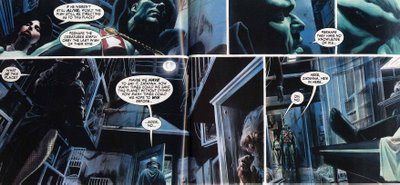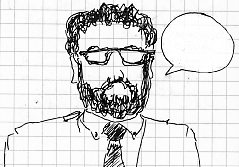Sunday, September 17, 2006
A Humane Perspective
I'm enjoying Alex Ross, Jim Kreuger, and Doug Braithwaite's Justice. Although the creators took their own sweet time in laying the groundwork for the title's multiple plot elements and cast of thousands, all that careful work has now paid off. The story is firing on all cylinders, and the five issues that remain would seem to provide the perfect amount of room for resolving the remaining plot points without needing to rush to the conclusion.
Justice delivers a dose of Silver Age-y goodness in every issue. For example, issue #7 presents a Zatanna who has not yet become a mind-wiping machine; a live Sue Dibny; a Hawk-couple who kick ass and bicker over Carter's communication skills at the same time; a Dr. Niles Caulder who is not a wanker; and, of course, a non-angst-ridden Doom Patrol. (For the name of their team alone, I love the Doom Patrol.)
But it's not just the nostalgia that keeps me reading this title. Krueger has scripted an engaging story which Braithwaite and Ross complement with dynamic and interesting artwork. And what I like most about Justice is that the human element is actually integrated throughout the visual and written elements of the story. You get the sense that the characters care about one another. (What can I say? I am on record as a proud, self-professed fangirl.)
Most importantly, the characters go beyond saying that they care about each other, (something the Teen Titans did continuously during the Wolfman/Perez years), to actually expressing, through actions large and small, that they might be believably "real" characters with recognizable human(oid) emotions and feelings for one another.
There's an extreme situation in issue #7 that gets at this point. Zatanna and the Martian Manhunter have finally learned the location of the missing Aquaman, and head out to a warehouse/lab facility to rescue him. (In issue #2 Aquaman was captured, and Brainiac was headed in his direction with one of those menacing-looking surgical saws.)
Braithwaite and Ross make good use of cinematic angles of perspective to re-inforce Zatanna and J'onn's concern for Aquaman in this sequence of panels:
 The center of focus is different in each of those panels, which nicely conveys a sense of movement and disorientation. The deep close-up on J'onn's face actually shows him shedding a tear, while Zatanna is depicted with her hands up to her face in the following panel.
The center of focus is different in each of those panels, which nicely conveys a sense of movement and disorientation. The deep close-up on J'onn's face actually shows him shedding a tear, while Zatanna is depicted with her hands up to her face in the following panel.
The effect is brought home on the next page when the we get the villain's-eye-view of J'onn and Zatanna as they discover Aquaman's lifeless body:
 Aquaman is brought to the Doom Patrol's lab, where he's observed by Dr. Caulder. In this next panel, the Chief is foregrounded as he provides vital information, but the artists also take the care to assure that J'onn's and Zatanna's body language convey information about the characters, even though they're far in the background of the image.
Aquaman is brought to the Doom Patrol's lab, where he's observed by Dr. Caulder. In this next panel, the Chief is foregrounded as he provides vital information, but the artists also take the care to assure that J'onn's and Zatanna's body language convey information about the characters, even though they're far in the background of the image.
 The heroes have confronted separate enemy attacks in the previous issues; most of them are reunited in #7 for the first time since the villains unleashed their assaults. Wonder Woman has gone mano-a-claw with the Cheetah, and her comrades react with a realistic mixture of alarm, concern, and surprise when they first observe Diana's battle scars near the end of the issue.
The heroes have confronted separate enemy attacks in the previous issues; most of them are reunited in #7 for the first time since the villains unleashed their assaults. Wonder Woman has gone mano-a-claw with the Cheetah, and her comrades react with a realistic mixture of alarm, concern, and surprise when they first observe Diana's battle scars near the end of the issue.
 The panel is nicely done: the Flash delivers the obvious line of dialogue and tactful thought balloon; Plastic Man's frown and wrinkled brow are revelatory, as is Black Canary's steady gaze and outstretched hand. We learn in the following panel that Diana has averted her eyes not because she is ashamed of how the scars have made her look; rather, she's embarrassed to be the center of her friends' attention over a set of wounds which she considers to be superficial.
The panel is nicely done: the Flash delivers the obvious line of dialogue and tactful thought balloon; Plastic Man's frown and wrinkled brow are revelatory, as is Black Canary's steady gaze and outstretched hand. We learn in the following panel that Diana has averted her eyes not because she is ashamed of how the scars have made her look; rather, she's embarrassed to be the center of her friends' attention over a set of wounds which she considers to be superficial.
I really appreciate this title's careful attention to complex and humane visual story-telling.
Justice delivers a dose of Silver Age-y goodness in every issue. For example, issue #7 presents a Zatanna who has not yet become a mind-wiping machine; a live Sue Dibny; a Hawk-couple who kick ass and bicker over Carter's communication skills at the same time; a Dr. Niles Caulder who is not a wanker; and, of course, a non-angst-ridden Doom Patrol. (For the name of their team alone, I love the Doom Patrol.)
But it's not just the nostalgia that keeps me reading this title. Krueger has scripted an engaging story which Braithwaite and Ross complement with dynamic and interesting artwork. And what I like most about Justice is that the human element is actually integrated throughout the visual and written elements of the story. You get the sense that the characters care about one another. (What can I say? I am on record as a proud, self-professed fangirl.)
Most importantly, the characters go beyond saying that they care about each other, (something the Teen Titans did continuously during the Wolfman/Perez years), to actually expressing, through actions large and small, that they might be believably "real" characters with recognizable human(oid) emotions and feelings for one another.
There's an extreme situation in issue #7 that gets at this point. Zatanna and the Martian Manhunter have finally learned the location of the missing Aquaman, and head out to a warehouse/lab facility to rescue him. (In issue #2 Aquaman was captured, and Brainiac was headed in his direction with one of those menacing-looking surgical saws.)
Braithwaite and Ross make good use of cinematic angles of perspective to re-inforce Zatanna and J'onn's concern for Aquaman in this sequence of panels:
 The center of focus is different in each of those panels, which nicely conveys a sense of movement and disorientation. The deep close-up on J'onn's face actually shows him shedding a tear, while Zatanna is depicted with her hands up to her face in the following panel.
The center of focus is different in each of those panels, which nicely conveys a sense of movement and disorientation. The deep close-up on J'onn's face actually shows him shedding a tear, while Zatanna is depicted with her hands up to her face in the following panel.The effect is brought home on the next page when the we get the villain's-eye-view of J'onn and Zatanna as they discover Aquaman's lifeless body:
 Aquaman is brought to the Doom Patrol's lab, where he's observed by Dr. Caulder. In this next panel, the Chief is foregrounded as he provides vital information, but the artists also take the care to assure that J'onn's and Zatanna's body language convey information about the characters, even though they're far in the background of the image.
Aquaman is brought to the Doom Patrol's lab, where he's observed by Dr. Caulder. In this next panel, the Chief is foregrounded as he provides vital information, but the artists also take the care to assure that J'onn's and Zatanna's body language convey information about the characters, even though they're far in the background of the image. The heroes have confronted separate enemy attacks in the previous issues; most of them are reunited in #7 for the first time since the villains unleashed their assaults. Wonder Woman has gone mano-a-claw with the Cheetah, and her comrades react with a realistic mixture of alarm, concern, and surprise when they first observe Diana's battle scars near the end of the issue.
The heroes have confronted separate enemy attacks in the previous issues; most of them are reunited in #7 for the first time since the villains unleashed their assaults. Wonder Woman has gone mano-a-claw with the Cheetah, and her comrades react with a realistic mixture of alarm, concern, and surprise when they first observe Diana's battle scars near the end of the issue. The panel is nicely done: the Flash delivers the obvious line of dialogue and tactful thought balloon; Plastic Man's frown and wrinkled brow are revelatory, as is Black Canary's steady gaze and outstretched hand. We learn in the following panel that Diana has averted her eyes not because she is ashamed of how the scars have made her look; rather, she's embarrassed to be the center of her friends' attention over a set of wounds which she considers to be superficial.
The panel is nicely done: the Flash delivers the obvious line of dialogue and tactful thought balloon; Plastic Man's frown and wrinkled brow are revelatory, as is Black Canary's steady gaze and outstretched hand. We learn in the following panel that Diana has averted her eyes not because she is ashamed of how the scars have made her look; rather, she's embarrassed to be the center of her friends' attention over a set of wounds which she considers to be superficial.I really appreciate this title's careful attention to complex and humane visual story-telling.
Comments:
<< Home
Alex Ross is far more than just a cover artist.
There are other artists who have photo realistic, painted styles, but can't pull off essential storytelling techniques needed in comics. They come off no better than tacking on word balloons onto photos.
Alex knows Sequential Art Storytelling, but then again he's been doing this since "Marvels".
Post a Comment
There are other artists who have photo realistic, painted styles, but can't pull off essential storytelling techniques needed in comics. They come off no better than tacking on word balloons onto photos.
Alex knows Sequential Art Storytelling, but then again he's been doing this since "Marvels".
<< Home

